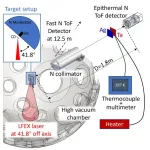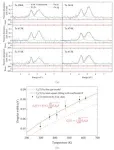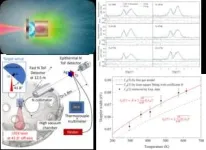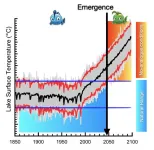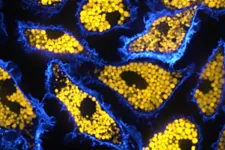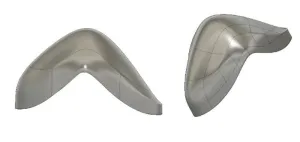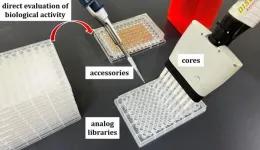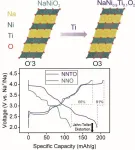(Press-News.org) Osaka, Japan – From LEDs to batteries, our lives are full of electronics, and there is a constant push to make them more efficient and reliable. But as components become increasingly sophisticated, getting reliable temperature measurements of specific elements inside an object can be a challenge.
This is problematic because measuring a device’s temperature is vital for monitoring its performance or designing the materials from which it’s manufactured. Now, in a new study led by Osaka University, neutrons have been used to measure temperatures quickly and accurately, which could eventually lead to improved performance for all kinds of electronics.
There have been a few ways to estimate the temperature inside an electronic device, but none have been able to give a fast, direct measurement. This new method uses a technique called ‘neutron resonance absorption’ (NRA): by examining neutrons being absorbed by atomic nuclei at certain energy levels, the properties of the material can be deduced.
The neutrons in this study were generated using high-intensity laser beams. The neutrons are then decelerated to a very low energy level before being passed through a sample. The technique was tested using plates of tantalum and silver, successfully returning details about the materials and temperatures with exceptional speed.
The researchers could determine the temperature of the samples because the temporal signal of the NRA was altered in a predictable manner when the sample material’s temperature was changed.
“This technology makes it possible to instantaneously and accurately measure temperature,” explains Zechen Lan, lead author. “As our method is non-destructive, it can be used to monitor devices like batteries and semiconductor devices.”
As the NRA measurement is performed with a single pulse of neutrons, the newly developed technique can acquire temperature data in a window of 100 nanoseconds, i.e., one ten-millionth of a second. This near-instant result means changes within a material can be measured in close to real time, allowing detailed analysis.
“Using lasers to generate and accelerate ions and neutrons is nothing new, but the techniques we’ve developed in this study represent an exciting advance,” says senior author Akifumi Yogo. “We expect that the high temporal resolution will allow electronics to be examined in greater detail, help us to understand normal operating conditions, and pinpoint abnormalities.”
As an additional accomplishment, the measurement device developed by the research team is about a tenth of the size of other similar equipment, meaning that it will be easy for laboratories elsewhere to install their own versions.
Being able to quickly and accurately measure the operating temperatures of devices, and the materials from which they are made, can advance our understanding of how they function and can be further improved in the future.
###
The article, “Single-Shot Laser-Driven Neutron Resonance Spectroscopy for Temperature Profiling” was published in Nature Communications at DOI: https://doi.org/10.1038/s41467-024-49142-y
About Osaka University
Osaka University was founded in 1931 as one of the seven imperial universities of Japan and is now one of Japan's leading comprehensive universities with a broad disciplinary spectrum. This strength is coupled with a singular drive for innovation that extends throughout the scientific process, from fundamental research to the creation of applied technology with positive economic impacts. Its commitment to innovation has been recognized in Japan and around the world. Now, Osaka University is leveraging its role as a Designated National University Corporation selected by the Ministry of Education, Culture, Sports, Science and Technology to contribute to innovation for human welfare, sustainable development of society, and social transformation.
Website: https://resou.osaka-u.ac.jp/en
END
Neutrons give a hot new way to measure the temperature of electronic components
Our modern world is full of temperature-sensitive electronic devices, and researchers led by Osaka University have developed a faster, highly accurate way to measure the temperatures of such devices using neutrons
2024-07-12
ELSE PRESS RELEASES FROM THIS DATE:
High and low tide cause low and high methane fluxes
2024-07-12
High and low tide cause low and high methane fluxes
Methane, a strong greenhouse gas that naturally escapes from the bottom of the North Sea, is affected by the pressure of high or low tide. Methane emissions from the seafloor can be just easily three times as much or as little, depending on the tide. This is shown by NIOZ oceanographer Tim de Groot, in a publication in Nature Communications Earth and Environment. "Our research shows that you can never rely on one measurement when you want to know how much methane escapes from the seafloor," De Groot emphasizes.
Swamp ...
A better way to make RNA drugs
2024-07-12
While the COVID-19 vaccines introduced many people to RNA-based medicines, RNA oligonucleotides have already been on the market for years to treat diseases like Duchenne Muscular Dystrophy and amyloidosis. RNA therapies offer many advantages over traditional small molecule drugs, including their ability to address almost any genetic component within cells and to guide gene editing tools like CRISPR to their targets.
However, the promise of RNA is currently limited by the fact that rapidly growing global demand is outpacing the industry’s ability to manufacture it. The standard method of chemically ...
Unprecedented warming threatens earth’s lakes and their ecosystems
2024-07-12
Lakes, with their rich biodiversity and important ecological services, face a concerning trend: rapidly increasing temperatures. A recent study published in Nature Geoscience by an international team of limnologists and climate modelers reveals that if current anthropogenic warming continues until the end of this century, lakes worldwide will likely experience pervasive and unprecedented surface and subsurface warming, far outside the range of what they have encountered before.
The study uses lake temperature ...
Cellular inflammation uncovered in rare neurodegenerative condition
2024-07-12
Researchers at The Hospital for Sick Children (SickKids) have found that inflammation in an immune cell may be responsible in part for some severe symptoms in a group of rare genetic conditions called lysosomal storage diseases (LSDs).
LSDs affect about one in 7,700 live births worldwide. Children with the condition typically present at a young age with progressive neurodegeneration. Many children with LSDs die prematurely, and current treatments focus on symptom management.
Until now, the role of macrophages in the immune system and LSDs was ...
Insight into one of life’s earliest ancestors revealed in new study
2024-07-12
An international team of researchers led by the University of Bristol has shed light on Earth’s earliest ecosystem, showing that within a few hundred million years of planetary formation, life on Earth was already flourishing.
Everything alive today derives from a single common ancestor known affectionately as LUCA (Last Universal Common Ancestor).
LUCA is the hypothesized common ancestor from which all modern cellular life, from single celled organisms like bacteria to the gigantic redwood trees (as well as us humans) descend. LUCA represents the root ...
Real-life ‘stillsuit’: Dune-inspired upgrade for spacesuits allow astronauts to recycle urine into water
2024-07-12
Astronauts on spacewalks famously have to relieve themselves inside their spacesuits. Not only is this uncomfortable for the wearer and unhygienic, it is also wasteful, as – unlike wastewater on board the International Space Station (ISS) – the water in urine from spacewalks is not recycled.
A solution for these challenges would be full-body ‘stillsuits’ like those in the blockbuster Dune franchise, which absorbed and purified water lost through sweating and urination, and recycled it into drinkable water. Now, this sci-fi ...
A comprehensive derivative synthesis method for development of new antimicrobial drugs
2024-07-12
A method to screen a wide variety of drug candidates without laborious purification steps could advance the fight against drug-resistant bacteria.
Efforts to combat the increasing threat of drug-resistant bacteria are being assisted by a new approach for streamlining the search for antimicrobial drug candidates, pioneered by researchers at Hokkaido University, led by Assistant Professor Kazuki Yamamoto and Professor Satoshi Ichikawa of the Faculty of Pharmaceutical Sciences. Their methods, developed together with researchers elsewhere in Japan and in the USA, are discussed ...
Improving cycling performance of sodium-ion batteries through titanium substitution
2024-07-12
Researchers at Karlsruhe Institute of Technology (KIT) have made significant advances in sodium-ion battery (SIB) technology by improving cycling performance of the NaNiO2 cathode. They successfully synthesized, for the first time, the cathode active material NaNi0.9Ti0.1O2, which delivers a specific capacity of 190 mAh/g, thus positioning it as a potential candidate for application in high-energy-density SIBs. This innovative approach not only improves battery stability but also propels us toward advanced energy-storage solutions beyond.
With its high theoretical ...
Hatcheries can boost wild salmon numbers but reduce diversity
2024-07-12
The ability of salmon hatcheries to increase wild salmon abundance may come at the cost of reduced diversity among wild salmon, according to a new University of Alaska Fairbanks–led study.
The number of juvenile salmon released into the North Pacific Ocean by hatcheries increased rapidly in the second half of the last century and remains at over 5 billion each year. Salmon hatcheries have helped push annual pink salmon harvests in Prince William Sound from about 4 million fish prior to hatchery programs to roughly 50 million in recent years.
Using data collected from pink salmon streams ...
Artificial intelligence speeds up heart scans, saving doctors’ time, and could lead to better treatment for heart conditions
2024-07-12
Researchers created a computer model that uses AI to examine heart images from magnetic resonance imaging (MRI)
Results were comparable to those worked out by doctors manually, but instead of taking 45 minutes or more, the AI model takes just a few seconds
The AI model could lead to more efficient diagnoses, better treatment decisions and improved outcomes for patients
Researchers have developed a groundbreaking method for analysing heart MRI scans with the help of artificial ...
LAST 30 PRESS RELEASES:
Sleeping in on weekends may help boost teens’ mental health
Study: Teens use cellphones for an hour a day at school
After more than two years of war, Palestinian children are hungry, denied education and “like the living dead”
The untold story of life with Prader-Willi syndrome - according to the siblings who live it
How the parasite that ‘gave up sex’ found more hosts – and why its victory won’t last
When is it time to jump? The boiling frog problem of AI use in physics education
Twitter data reveals partisan divide in understanding why pollen season's getting worse
AI is quick but risky for updating old software
Revolutionizing biosecurity: new multi-omics framework to transform invasive species management
From ancient herb to modern medicine: new review unveils the multi-targeted healing potential of Borago officinalis
Building a global scientific community: Biological Diversity Journal announces dual recruitment of Editorial Board and Youth Editorial Board members
Microbes that break down antibiotics help protect ecosystems under drug pollution
Smart biochar that remembers pollutants offers a new way to clean water and recycle biomass
Rice genes matter more than domestication in shaping plant microbiomes
Ticking time bomb: Some farmers report as many as 70 tick encounters over a 6-month period
Turning garden and crop waste into plastics
Scientists discover ‘platypus galaxies’ in the early universe
Seeing thyroid cancer in a new light: when AI meets label-free imaging in the operating room
Neutrophil-to-lymphocyte ratio may aid risk stratification in depressive disorder
2026 Seismological Society of America Annual Meeting
AI-powered ECG analysis offers promising path for early detection of chronic obstructive pulmonary disease, says Mount Sinai researchers
GIMM uncovers flaws in lab-grown heart cells and paves the way for improved treatments
Cracking the evolutionary code of sleep
Medications could help the aging brain cope with surgery, memory impairment
Back pain linked to worse sleep years later in men over 65, according to study
CDC urges ‘shared decision-making’ on some childhood vaccines; many unclear about what that means
New research finds that an ‘equal treatment’ approach to economic opportunity advertising can backfire
Researchers create shape-shifting, self-navigating microparticles
Science army mobilizes to map US soil microbiome
Researchers develop new tools to turn grain crops into biosensors
[Press-News.org] Neutrons give a hot new way to measure the temperature of electronic componentsOur modern world is full of temperature-sensitive electronic devices, and researchers led by Osaka University have developed a faster, highly accurate way to measure the temperatures of such devices using neutrons
